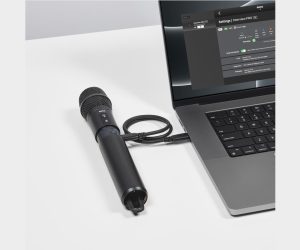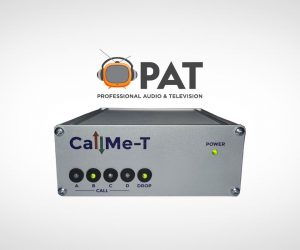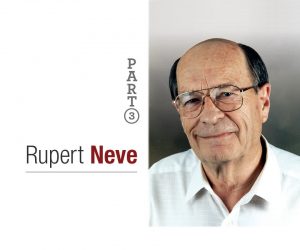
Interview with Bill Woodman
Greg Simmons talks with ATC’s founder, Bill Woodman, about eddy currents, resistive polymers, and hernias.
Greg Simmons: When was the problem of eddy current distortion discovered?
Bill Woodman: It was first documented in papers from Bell Laboratories, when loud speaker design began back in the late ‘20s, early ‘30s. They described it as a ‘distortion mechanism’, but no one has described the cause. So we made a practical working model of it and performed some tests. It was two years later, after analysing the test results and mathematics, that we were able to establish what those distortion mechanisms really were.
GS: Surely the problem isn’t only limited to speakers?
BW: No, not at all. It’s also a problem in communications transformers, and the techniques for limiting it in those applications involve the use of a powdered iron core, which offers reasonable magnetic performance and low conductivity. But it’s not magnetically suitable for use in a loudspeaker’s permanent magnetic circuit.
GS: They also use laminated iron cores in transformers to reduce eddy currents. Would that approach work for speakers?
BW: Theoretically, you could use laminations in the loudspeaker’s magnetic circuit, but the cost of making the components is such that it’s non-viable. You can’t hold the tolerances required for the air gap, and the assembly techniques are just horrendous.
GS: So you knew the cause of the problem, and you knew how the effects had been limited in other applications. How did you find the right material?
BW: About three years ago, we discovered the material that we now use in the SL drivers. It’s a powdered pure iron with an oxide coating, which stops it from conducting. It’s formed into whatever shape you want, like a ceramic material, except it’s bonded with a resin rather than the individual particles being fused together. It’s done under extremely high pressure, then heat treated to cure the resin. Finally, because it’s a porous material, it’s coated with PTFE to prevent corrosion.
GS: PTFE? Like Teflon?
BW: Yes. The result is a resistive polymer that we call SLMM — Super Linear Magnetic Material. The key to it is that the oxide and the resin are insulators, so it has very low conductivity. But because it contains pure iron, which has exceptional magnetic performance, SLMM ends up having magnetic characteristics that are only about 20% worse than the mild steel normally used in magnetic circuits. It’s also a good heat conductor, which is important in these applications.
GS: Won’t that 20% decrease affect the driver’s performance?
BW: The 20% decrease in performance of the SLMM has been compensated for in the design of the magnetic structure and, because there’s only a small amount of SLMM used on either side of the voice coil, the change in overall magnetic performance is small. There’s a layer on the pole piece and one on the front plate, and they’re both eight millimetres thick. If that was just mild steel, the eddy currents would form in the first half millimetre depth of the material, as a consequence of skin effect. But with the SLMM, the eddy currents penetrate the full depth, the whole eight millimetres. The eddy currents are the same, but now they’re spread out over a larger area.
GS: Does that mean there are less eddy currents in close proximity to the voice coil, and therefore less eddy current distortion induced back into it?
BW: Well, no… the levels of distortion induced by eddy currents remain basically the same. But because the eddy currents in the SLMM are spread over a larger area, they generate less opposition to the voice coil’s magnetic field. As a consequence, the impedance of the voice coil increases, and therefore the fundamental signal voltage across it also increases — but the induced distortion voltage remains the same. So the difference between the signal voltage and the induced distortion voltage increases. Our measurements show reductions of 10dB to 15dB in third harmonic distortion, from 100Hz to 3kHz.
GS: It’s mostly third harmonic distortion?
BW: Predominantly, yes. If you compare it to the fundamental signal, the distortion generated as a consequence of eddy currents is almost entirely third harmonic. That’s because the effect is controlled by hysteresis of the magnetic material, which is a non-linear characteristic. Third harmonic distortion is quite obtrusive, really. It used to show up at a very low level on the passive SCM20, you would hear it in things like the transients of a piano. But the most important thing now, with the Super Linear models, is that you hear more ambient information, and the low level overtones from things like cello and human voice are there. It just provides a truer tonal character to any sound.
GS: This form of distortion is obviously an inherent part of the sound produced by any moving coil speaker design, which probably explains my initial reaction to the SCM20A PROs…
BW: Which was?
GS: When they arrived in my studio, I immediately AB’d them against their predecessors, a pair of passive SCM20s. After listening to the passives for some time, I switched to the active PROs. The very first impression I had was that the passives had suddenly disappeared — as if someone had quickly removed them and left the bare speaker wires in their place, and the sound was now pouring out the ends of the wires. It was very weird…
BW: I’m sure that’s related to removing those distortion flaws, and of course the benefits of being an active system… There’s a couple of other interesting side effects that have come out of this, which we didn’t anticipate. When you lower that distortion floor, and it’s gone from -45dB down to -60dB, you get the impression of there being more low frequency.
GS: That’s unusual for harmonic distortion. Anyone who’s ever played with a synthesiser or a decent low pass filter would know that as you remove the harmonics, the subjective level of the fundamental decreases…
BW: Well, I don’t quite understand it, I still have trouble seeing it absolutely clearly. But the subjective effect is that, although the 6dB down point of the speaker’s low frequency response is very similar, they sound like there’s a lot more low frequency.
GS: The SCM20A PROs do have significantly better low frequency performance than the passive SCM20s. Is that purely a result of the reduction in distortion?
BW: No, the presence of the SLMM and the re-designed voice coil also changed the Q of the drive unit slightly. They’re still critically damped, but in comparison, the passive models were overdamped. Oh, and did you know that the active box is actually only 15 litres? Less volume in the enclosure, less damping, and better low frequencies.
GS: Speaking of the enclosure, I’m particularly intrigued by your use of die-cast aluminium…
BW: What prompted that was two-fold. Firstly, it removes the problems of having a rectangular box when you’re dealing with wood, where it’s difficult to make complex shapes. And secondly, we wanted to engineer the cost out of the box. When you make something active, you always end up with this huge aluminium plate and a great big heatsink, all bolted onto the back of a wooden box. If you could make the box and the heatsink as one, then you remove a layer of cost. It was those two things that motivated us to look at aluminium die casting. It’s also extraordinarily robust, from a user’s point of view.
GS: Does it introduce any resonance or ringing problems?
BW: A huge amount of the cabinet’s damping comes from the front baffle, which is 50mm thick and machined from solid MDF. When you bolt that onto the aluminium enclosure, it damps it completely. We also put bitumastic damping pads on the inside panels, of course, but it’s the mass of the front baffle that really damps any tendency of the enclosure to ring.
GS: What about the weight? At 33kg each, these ‘portable’ speakers are deceptively heavy for their size. Most sound engineers I know of don’t do weights…
BW: (Laughs). We’ve had some terrible faxes through — a very good friend of mine in California sent me a fax asking if we’d pay for his hernia! The weight is a problem, but nonetheless, they’re still portable — it’s not completely out of the question. We’re considering the possibility of putting a neodymium magnet on the bass driver, and changing the power supply, because we need to lose about four to six kilos. But, as you know, we always go for performance-lead designs. We’ll go after the performance first, and then improve the other factors.
GS: I’m afraid that’s all we’ve got room for, Bill. Thanks very much for your time.
BW: A pleasure.

















RESPONSES